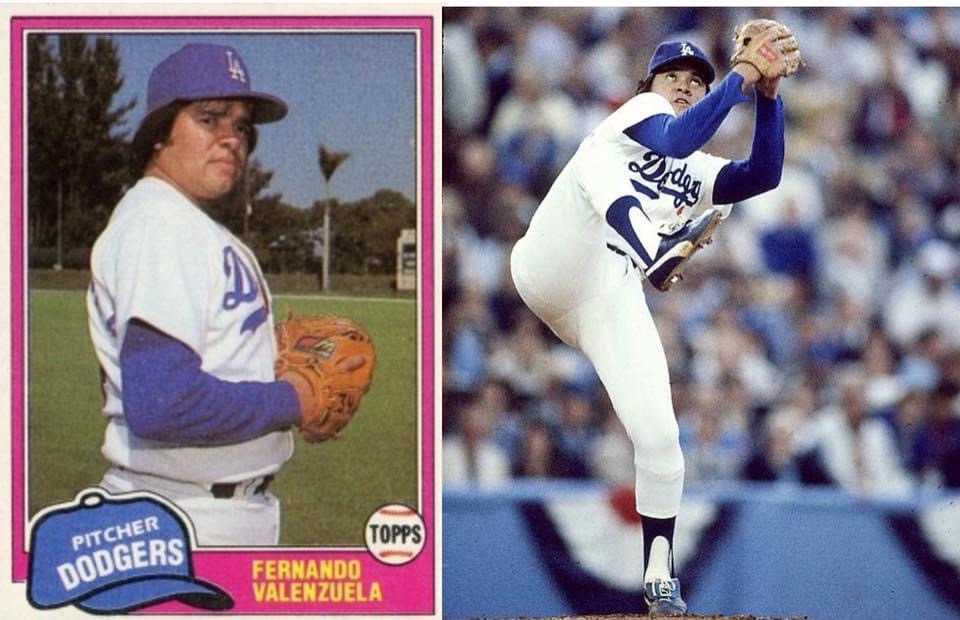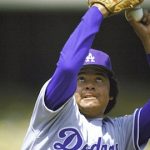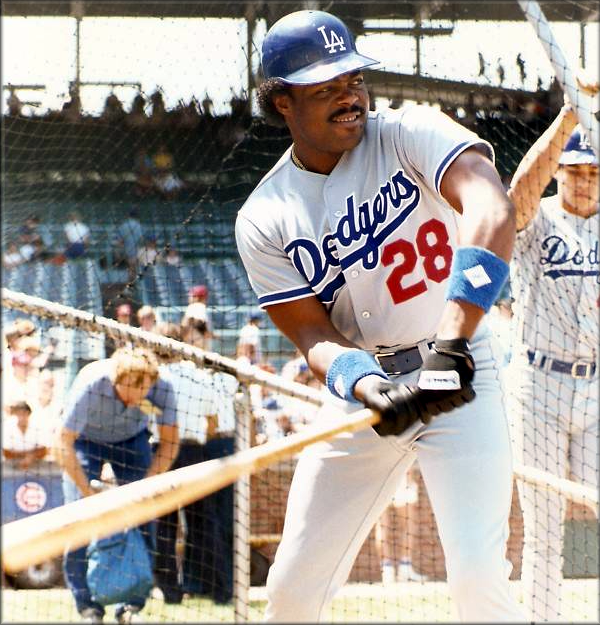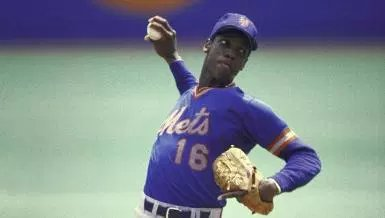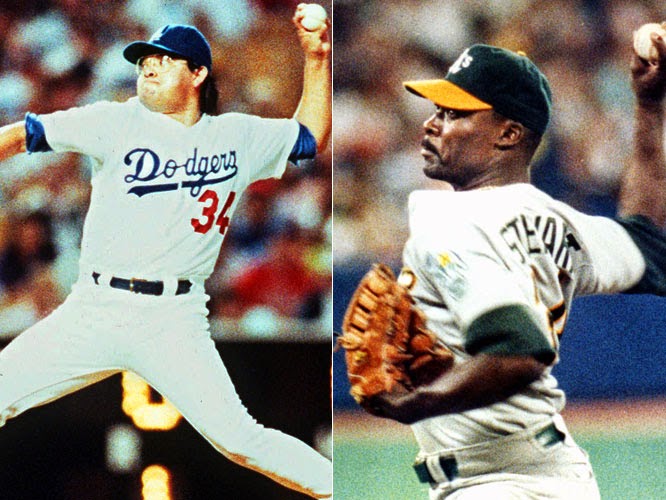Pedro Guerrero Career Highlights
Pedro Guerrero Career Highlights
Positions: First Baseman, Outfielder and Third Baseman
Bats: Right • Throws: Right 5-11, 176lb (180cm, 79kg)
Born: June 29, 1956 in San Pedro de Macoris, Dominican Republic do
Debut: September 22, 1978 (14,135th in major league history) vs. SDP 1 AB, 1 H, 0 HR, 0 RBI, 0 SB
Last Game: October 4, 1992 vs. PHI 1 AB, 0 H, 0 HR, 0 RBI, 0 SB
Rookie Status: Exceeded rookie limits during 1980 season
Full Name: Pedro Guerrero
View Player Info from the B-R Bullpen View Player Bio from the SABR BioProject
Nine Players Who Debuted in 1978
Paul Molitor
Ozzie Smith
Carney Lansford
Pedro Guerrero
Danny Darwin
Mike Morgan
Dave Stewart
Terry Kennedy
Ron Oester
All-Time Teammate Team
Coming Soon
Notable Events and Chronology
Biography
Writer Bill James called Guerrero “the best hitter God has made in a long time.” Originally signed as a free agent by the Indians, Guerrero was virtually stolen by the Dodgers after his first pro season, acquired in exchange for pitching flop Bruce Ellingsen. He first hit the limelight when his five RBIs in the final game of the 1981 World Series gave him a piece of the first three-way Series MVP award. In 1982 he became the first Dodger to hit 30 HR and steal 20 bases in a season, and he did it again the following year. In 1985 Guerrero tied a major league record with 15 HR in June, en route to tying the Los Angeles record of 33. He also reached base 14 consecutive times that year, two shy of Ted Williams’s record, and led the league in slugging, on-base and home run percentage. Guerrero also played in St. Louis and contended for a MVP and after 1993 was out of Proffesional Baseball. In September 1999, Guerrero was arrested for trying to buy 33 pounds of cocaine from an undercover agent.
Los Angeles Dodgers Originally signed as a free agent by the Indians, Guerrero was acquired by the Dodgers in exchange for pitcher Bruce Ellingsen. He broke into the Dodger lineup as a replacement for the injured Davey Lopes at second base. Guerrero had five RBIs in the final game of the 1981 World Series, which earned him a piece of the first three-way Series MVP award (sharing the award with Ron Cey and Steve Yeager). In somewhat of a symbol of the insufficient attention he received during his impressive career, he was the only one of the three not to be interviewed during the nationally televised post-game celebration. In 1982, he became the first Dodger to hit 30 home runs and steal 20 bases in a season, and he did it again the following year. In 1985, Guerrero tied a major league record with 15 home runs in June, and also tied the Los Angeles season record of 33. He reached base 14 consecutive times that year, two short of the record set by Ted Williams, and led the league in slugging, on-base and home run percentage. Guerrero was an aggressive baserunner but a poor slider. He ruptured a tendon sliding in spring training and missed most of the 1986 season, after which he ran less frequently. But in 1987 he batted .338 and won the UPI’s Comeback Player of the Year award. His batting average that year was the highest by any Dodger since the .346 recorded by Tommy Davis in 1962. Dodger management appeared to believe him capable of any athletic feat, and they thought nothing of shifting him to third base in mid-career, and in and out as the need arose. Although he gained a reputation for being shaky at third, statistics show that he was about as good as anyone in the league at getting to the ball. In the minors he made all-star teams at both first base and third base, and he broke into the Dodger lineup as a replacement for the injured Davey Lopes at second base. Guerrero was traded to the Cardinals for pitcher John Tudor during the 1988 season and missed out on the Dodgers’ World Championship that fall. Guerrero had enough left for one more spectacular season, batting .311 with 17 home runs, a career-high 117 RBIs and a league-high 42 doubles in 1989, but his production fell off sharply afterwards. He finished his career batting just .219 with one home run in 1992 as a shoulder injury limited him to 43 games. In a classic (and probably apocryphal) tale, manager Tommy Lasorda was talking to Guerrero about how to field third base at a time when Steve Sax was having his problems at second base – and it went something like this: “Tommy: Pedro, suppose the bases are loaded. What are you thinking about the next hitter? Pedro: “I’m thinking ‘Don’t hit it to me’. Tommy: Come on, what else are you thinking? Pedro: I’m thinking ‘Don’t hit it to Saxxy either‘.” During his Dodger tenure he was third in the MVP voting three times – twice with the Dodgers and once with the St. Louis Cardinals. He was World Series co-MVP in 1981, when the Dodgers won the World Series. He was also a key member of the division-winning Dodger teams in 1983 and 1985, and was part of the 1988 Dodgers who went on to win the World Series until he was traded to the Cardinals (for pitcher John Tudor) in mid-season – at the time he was hitting .298 with a good on-base percentage but not much power. His departure was hastened by the arrival of a new teammate. That year the Dodgers were led by the fiery Kirk Gibson, who won the NL MVP award and hit a legendary World Series home run. Oil and water mix together better than Pedro and Kirk.
St. Louis Cardinals During Los Angeles’ 1988 championship season, he was traded to the Cardinals for pitcher John Tudor. In 1989, Guerrero earned serious MVP consideration, batting .311 with 17 home runs, a career-high 117 RBIs and a league-high 42 doubles. His production fell off sharply afterwards. In 1992 a shoulder injury limited him to 43 games, and he finished his major league career batting just .219 with one home run.
Independent leagues and Mexico In 1993, after becoming a free agent and not finding a new major league team, Guerrero signed with the independent Sioux Falls Canaries of the Northern League. He split the season between the Canaries and the Charros de Jalisco of the Mexican League. He returned to the Canaries in 1994, then made one more attempt at a comeback in 1995 with the Midland Angels, the Double-A farm team of the California Angels before retiring.
Post-baseball In September 1999, Guerrero was arrested for trying to buy 33 pounds of cocaine from an undercover agent. In June 2002, he was acquitted of drug conspiracy charges after his attorney argued his low IQ prevented him from understanding that he had agreed to a drug deal. Later in 1999, O.J. Simpson claimed in a call to 911 that his then girlfriend, Christie Prody, was missing and had been using drugs for two days with Guerrero.
Fast Facts: In 2011, Guerrero joined the Arizona Winter League as a hitting instructor The two most similar players through 2006, according to the similarity scores method, are Rico Carty and Ben Oglivie, although Pedro has a higher Adjusted OPS+ than either of them. Guerrero’s half-brother, Domingo Michel, was a minor league and CPBL outfielder from 1984-1999 and coached for the DSL White Sox in 2010. Guerrero, who was born in 1956, played quite a few seasons in the minors – with a career minor league batting average of .319. He started in the minors in 1973, becoming a major league regular only in 1980. Sources: BR Bullpen, Wikipedia, Baseball Library
@ET-DC@eyJkeW5hbWljIjp0cnVlLCJjb250ZW50IjoicG9zdF90YWdzIiwic2V0dGluZ3MiOnsiYmVmb3JlIjoiTGVhcm4gTW9yZSBhYm91dCB0aGUgdGVhbXMsIHBsYXllcnMsIGJhbGwgcGFya3MgYW5kIGV2ZW50cyB0aGF0IGhhcHBlbmVkIG9uIHRoaXMgZGF0ZSBpbiBoaXN0b3J5IC0gLSAtIC0gLSAtIC0gIiwiYWZ0ZXIiOiIiLCJsaW5rX3RvX3Rlcm1fcGFnZSI6Im9uIiwic2VwYXJhdG9yIjoiIHwgIiwiY2F0ZWdvcnlfdHlwZSI6InBvc3RfdGFnIn19@
Factoids, Quotes, Milestones and Odd Facts
Coming soon
Other Resources & Links
Coming Soon
If you would like to add a link or add information for player pages, please contact us here.



